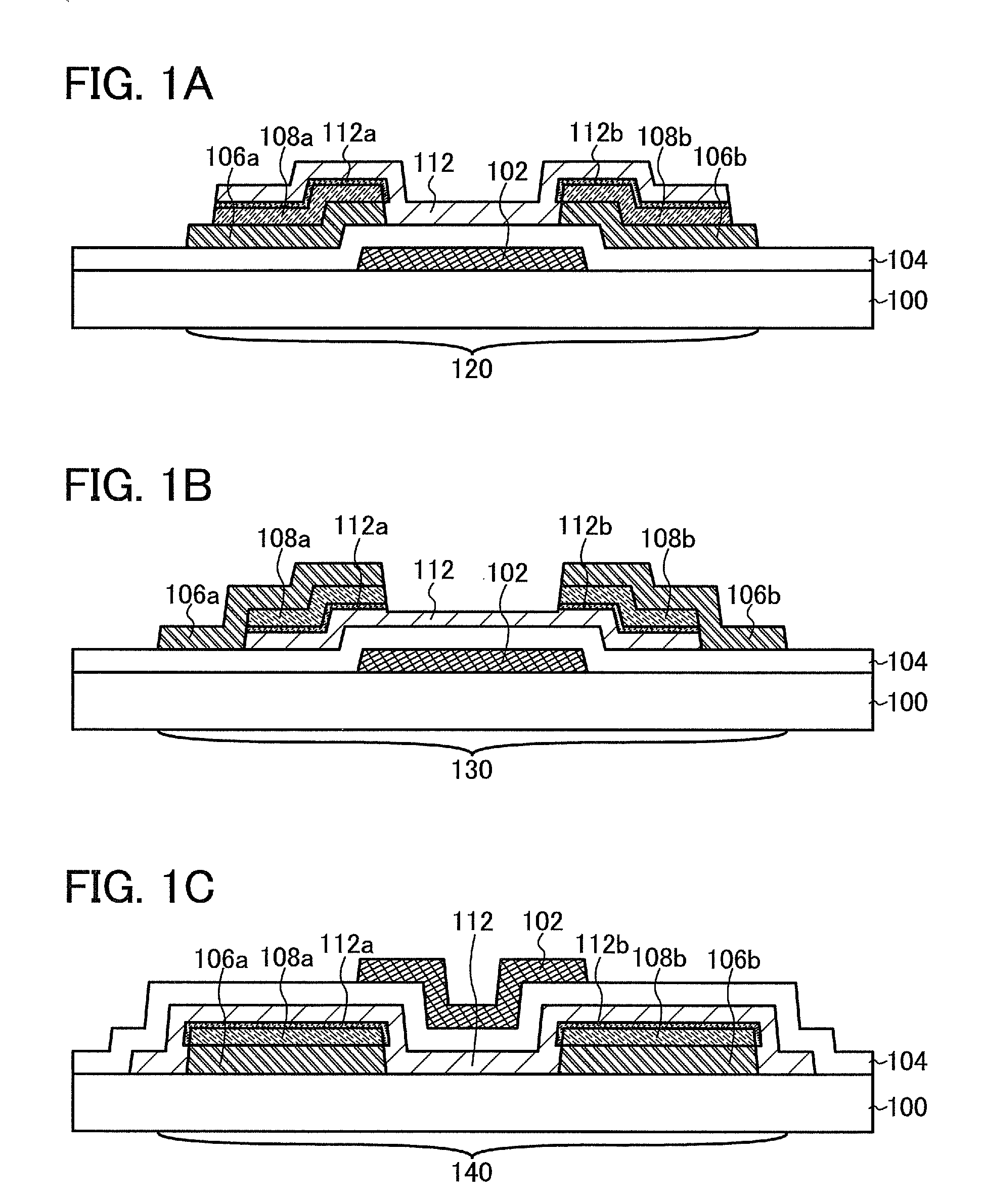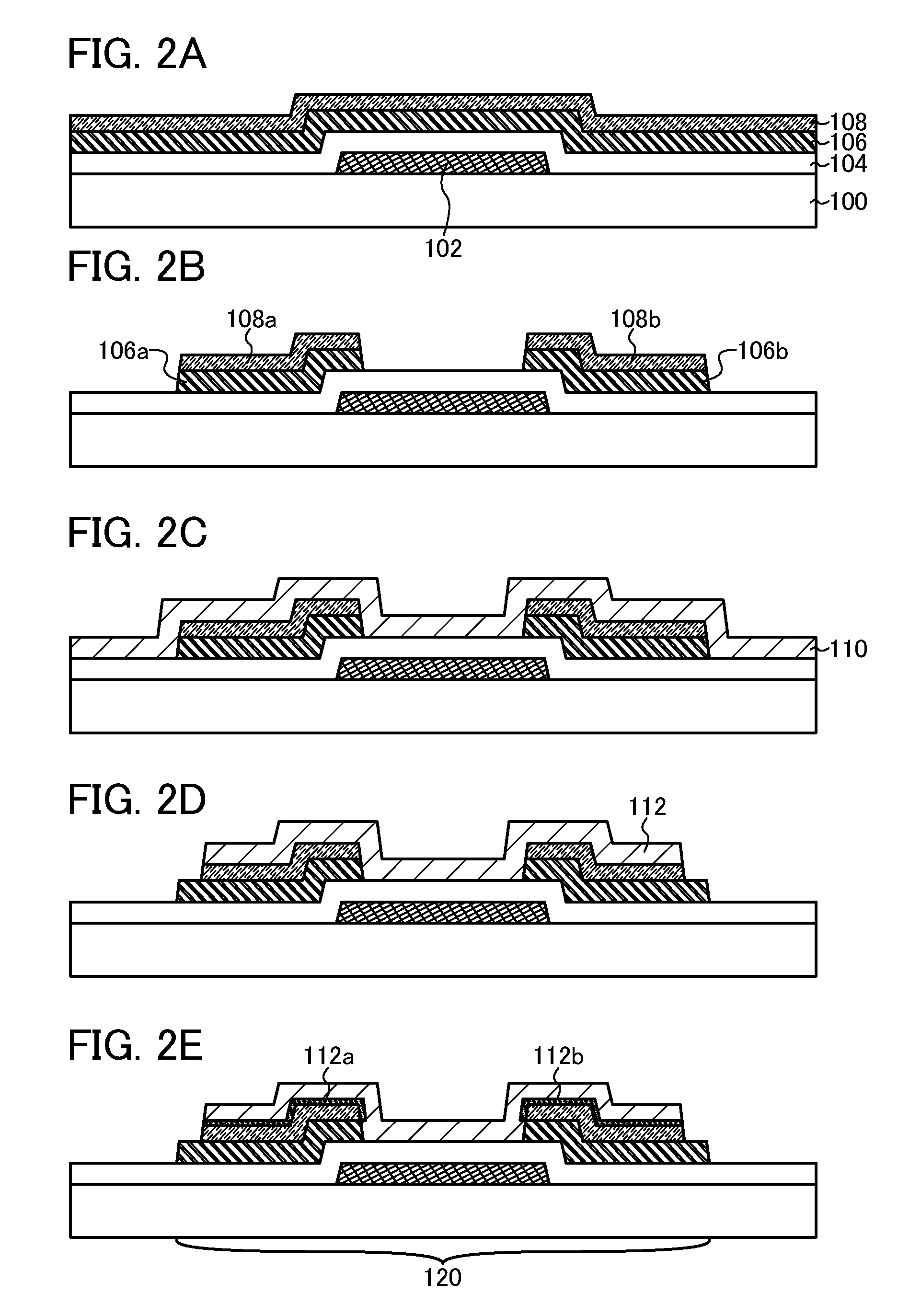Transistor and method for manufacturing the transistor
a transistor and semiconductor technology, applied in the field of transistors, can solve the problems of increasing drain electrode layer, and achieve the effect of reducing the characteristic variation of transistors, reducing the contact resistance between the oxide semiconductor layer and the source electrode layer and the drain electrode layer
- Summary
- Abstract
- Description
- Claims
- Application Information
AI Technical Summary
Benefits of technology
Problems solved by technology
Method used
Image
Examples
embodiment 1
[0050]In this embodiment, examples of a structure of a transistor are described with reference to FIGS. 1A to 1C.
[0051]A transistor described in this embodiment includes a gate electrode 102, a gate insulating layer 104, a source electrode layer 106a, a drain electrode layer 106b, a first metal oxide layer 108a electrically connected to the source electrode layer 106a, a second metal oxide layer 108b electrically connected to the drain electrode layer 106b, and an oxide semiconductor layer 112 to be a channel layer. The oxide semiconductor layer 112 is provided in a region which overlaps with the gate electrode 102 with the gate insulating layer 104 interposed therebetween and is between the source electrode layer 106a and the drain electrode layer 106b. In addition, the oxide semiconductor layer 112 is provided in contact with the first metal oxide layer 108a and the second metal oxide layer 108b.
[0052]In the oxide semiconductor layer 112 to be a channel layer, a crystal structure...
embodiment 2
[0071]In this embodiment, an example of a manufacturing method in a case of using a bottom-gate transistor in the structure described in Embodiment 1 (the case illustrated in FIG. 1A) is described with reference to drawings.
[0072]First, the gate electrode 102 is formed over the substrate 100, and subsequently, the gate insulating layer 104 is formed over the gate electrode 102. Then, the conductive film 106 and the metal oxide layer 108 are sequentially stacked over the gate insulating layer 104 (see FIG. 2A).
[0073]As the substrate 100, a substrate having an insulating surface may be used, and for example, a glass substrate can be used. In addition, as the substrate 100, an insulating substrate formed using an insulator such as a ceramic substrate, a quartz substrate, or a sapphire substrate; a semiconductor substrate which is formed using a semiconductor material such as silicon and whose surface is covered with an insulating material; or a conductive substrate which is formed usin...
embodiment 3
[0127]In this embodiment, an example of a manufacturing method in a case of using a bottom-gate transistor in the structure described in Embodiment 1 (the case illustrated in FIG. 1B) is described with reference to drawings. Note that the manufacturing process (a material and the like which can be used) described in this embodiment has a lot in common with that described in Embodiment 2. Thus, description of the common portions is omitted, and different portions are described in detail below.
[0128]First, the gate electrode 102 is formed over the substrate 100, and subsequently, the gate insulating layer 104 is formed over the gate electrode 102. Then, the oxide semiconductor layer 110 and the metal oxide layer 108 are sequentially stacked over the gate insulating layer 104 (see FIG. 5A).
[0129]The oxide semiconductor layer 110 and the metal oxide layer 108 can be successively formed without exposure to the air. For example, after the oxide semiconductor layer 110 is formed by a sputt...
PUM
 Login to View More
Login to View More Abstract
Description
Claims
Application Information
 Login to View More
Login to View More - R&D
- Intellectual Property
- Life Sciences
- Materials
- Tech Scout
- Unparalleled Data Quality
- Higher Quality Content
- 60% Fewer Hallucinations
Browse by: Latest US Patents, China's latest patents, Technical Efficacy Thesaurus, Application Domain, Technology Topic, Popular Technical Reports.
© 2025 PatSnap. All rights reserved.Legal|Privacy policy|Modern Slavery Act Transparency Statement|Sitemap|About US| Contact US: help@patsnap.com



